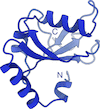issue contents
May 2021 issue

Cover illustration: Enoyl-CoA hydratase from Thermus thermophilus HB8. [Padavattan et al. (2021), Acta Cryst. F77, 148–155]. Fatty-acid degradation is an oxidative process that involves four enzymatic steps and is referred to as the β-oxidation pathway. Enoyl-CoA hydratase (ECH) catalyzes the second step of this pathway. During this process, long-chain acyl-CoAs are broken down into acetyl-CoA, which enters the mitochondrial tricarboxylic acid (TCA) cycle, resulting in the production of energy in the form of ATP.
research communications
 access
access access
access

 journal menu
journal menu
















![[publBio]](/logos/publbio.gif)





